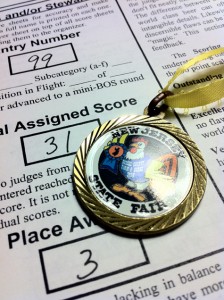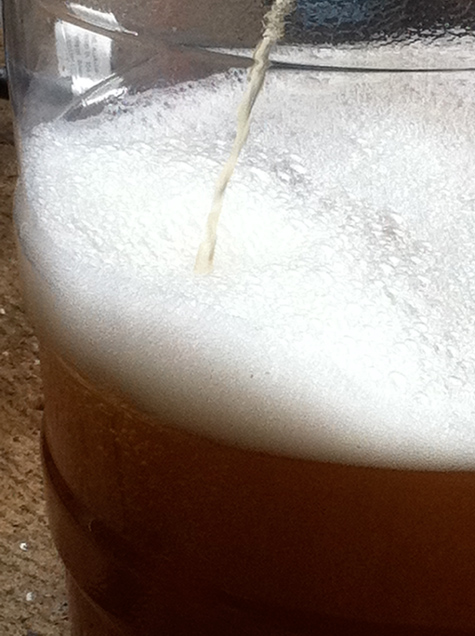NJ State Fair Results Feedback – Lessons Learned
 Last week I posted a frustrated write-up on “Where’s My Feedback“, for a best-in-show competition I was in. Today, I’m going to review the good and bad of my results from the NJ State Fair. This year I had much higher expectations for myself then last year. Last year I won Best of Show, so I was ready for a repeat. Unfortunately that was not in the cards for me this year. But, as in years past I received some great feedback that hopefully I can apply to future beer and maybe will help you not repeat my mistakes.
Last week I posted a frustrated write-up on “Where’s My Feedback“, for a best-in-show competition I was in. Today, I’m going to review the good and bad of my results from the NJ State Fair. This year I had much higher expectations for myself then last year. Last year I won Best of Show, so I was ready for a repeat. Unfortunately that was not in the cards for me this year. But, as in years past I received some great feedback that hopefully I can apply to future beer and maybe will help you not repeat my mistakes.
Not sure if I should start from the worst or the best. Ok, the worst it is…
Ok Lets start with my Scottish 60 -/ (Category 9A). This beer scored 23, 25, & 25 out of 50. Pretty much in line with what I thought it would be. This 60 schilling was not brewed to be a 60 schilling, in fact it was the 2nd runnings form a Peat Smoked Wee Heavy. I figured since this beer was under 4% abv and from a Wee Heavy, the 60 -/ (Scottish Light ) was the most appropriate category. One judge clearly nailed one of the biggest problems, a husky astringency from over sparging. I only made a 2.5 gal batch from the 2nd runnings, but clearly the over sparge was a big issue. The second runnings could have been helped from a small addition of some base malt to pull those additional sugars with out the tannins from the husks. One judge detected Diacetyl in the beer, I didn’t find that, but everyone has different levels of sensitivity. Here are their overall impressions:
Judge 1 (Master) -> A good attempt at a tough style. Needs more malt sweetness, complexity upfront. Too Husky/Grainy (oversparging?) If all grain brewing increase malt in mash. (Score: 23)
Judge 2 (Non BJCP) -> Weak Body, Low abv. Nice Color, Slightly sweet, Good for category but light bodied with some phenolic after tones (Score: 25)
Judge 3 (Apprentice) -> Good effort. “Small Beers” difficult to make. Can’t hide infections. (Score :25)
The second Beer was an older brown ale. This is a beer that was the last beer bottled from the keg before I got the beer gun. I wasn’t sure what to expect from this beer, it was pretty good a couple months before the State Fair. Apparently that must have been the best it was, because the judges had some significant issues with it. I did manage to squeak out some average scores, 25 and 23, which actually surprised me based on their comments. Both Judges called it sour and infected, with to much carbonation. On the plus side they did like the appearance and aroma, probably the only thing that saved the scores with this beer. Without any real excuses for the infection in this beer is probably due to… hell I don’t know. Maybe it was the bottle, maybe the beer, maybe an act of god and I need to get FEMA involved. It’s one of the things that facinates me about beer, how one(billion) tiny little microbe(s) can totally kill a beer in a really short time. Here are the Judges overall impressions:
Judge 1 (Apprentice) -> Sour flavor dominates the flavor profile masking what might be a good hoppiness. Most likely infected (Score: 25)
Judge 2 (Master)-> This is an infected beer. You need to focus on sanitation. On the plus side this is a passable Oud Bruin. (Score: 23)
Before I move onto the third beer, one of the things I’ve noticed is my bottle process from the keg has issues somewhere. It seems that a lot of my beers that are in the bottle for a couple of months develop infections where the kegged versions are ok. I had a couple thoughts. First, the bottles are not being sanitized long enough. Or, the Sanitizer is old or not strong enough. Or, The caps or transfer line was not sanitized enough. Since these bad bottles, I got a beer gun which I hope will help, as well as using fresh sanitizer and going longer then the 30 sec recommendation. I love this part of brewing, making mistakes, trying to find the breakdown in your process, and correct it.
Now onto the better beers. This next beer, I’m not even sure why I entered it; I had three bottles around and thought it was pretty darn good. This beer was my first SMaSH beer (Single Malt and Single Hop) and a beer I had made for my wife’s birthday, Golden Promise and Centennial Hops. Since this was basically heavy hop beer on a light malt, I entered it in Category 10A, American Pale Ale. Unlike the previous 2 beers this beer actually scored very well, 40, 36 and 38. This biggest knock against this beer was the color and my heavy handed hop bill. I think the only thing I would change about this recipe, is add a bit of Crystal 40 to bump up the color and extra pound or 2 of base malt and mash at 154. Maybe even a smidgen more bittering hop. Granted adding the crystal malt would negate the SMaSH factor, but should make for a pretty good pale ale. While this didn’t place, my score sheet did indicate it went to a mini-BOS round. Here are the Judges overall impression:
Judge 1 (Certified) -> A two pint beer. Nicely done. (Score: 40)
Judge 2 (Apprentice) -> Has a nice dry finish – hops are a bit much in ????? – Possibly a more complex grain bill would ???? more malt complexities. A nice example of Pale Ale. (Score: 36)
Judge 3 (Apprentice) -> A pale, hoppy beer that stands to the lighter end of the category. Low malt character is reasonably balanced by the moderate bitterness but both could be increased. You may want to try lowering your fermentation temps slightly to reduce unwanted esters and get a cleaner beer. (Score: 38)
The last beer of this competition was not the highest scorer, but did squeak out a 3rd place in Cat 21A (Spiced, Herb, Veggie beer). This beer was inspired by my Iron Brewer competition (Batch 2, Round 1), was a runner up in the finals of the New Brew Thursday / Bison Brewery homebrew competition, and now a medalist! This beer doesn’t have a name, mearly known as the Cardamon Wit. This Organic wit beer used fresh herbs and fruit and at it’s peak had a wonderful balance with the Cardamon, ginger, and orange. I think by the time this beer reached the NJ State Fair, it had been bottled for a couple of months. The Judges scored this beer, 36, 31, 27. Quite a range. What I think held back this beer and what I’ve found about about cardamon in beer, it quickly blends into the beer and then falls out. This was also the big ding from the Judge who scored it a 27, the spice had fallen out. Here are the Judges overall impression:
Judge 1 (Certified) -> A very nice wit with a subtle amount of ginger that blends well with the orange & wheat. I don’t detect any cardamon so either increase or drop from the description. Well done I’d pay $ for this beer. (Score: 36)
Judge 2 (Apprentice) -> the core beer neads to support the adjuncts more but otherwise very nice beer (Score: 31)
Judge 3 (Novice) -> good attempt at the wit. Not much spice or herb flavor. Good summer time beer (Score: 27)
Both some ups and down with my scores, but this type of feedback is invaluable for homebrewers! Next week I’ll have more feedback from the Dominion Cup!




Great article – thanks for being brave enough to share the feedback. It is always helpful to get constructive feedback from competitions!
I just got my feedback from the Sam Adams Longshot competition with similar results. They said my beer didn’t fit the style, which is true. I brew beers that are good to drink and then when I send it to a competition, I just put down the category they are closest to, though the judges don’t always agree. My first entry was an American Wheat that they said was too German (I did use german hops) so it got docked down and I only got a 27 and a 30. Haven’t heard back on the other one yet.
Thanks Chris. Any competition is tough, judge is so subjective, but it is the feedback which makes it worth while. (Especially if you medal or win!)
Congrats! Those are all solid scores
Thanks Rob. What’s nice is it all lined up with where I thought the beer was, so I’m happy.